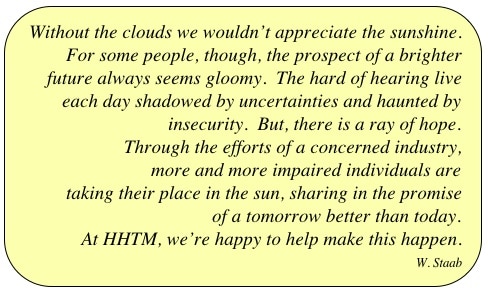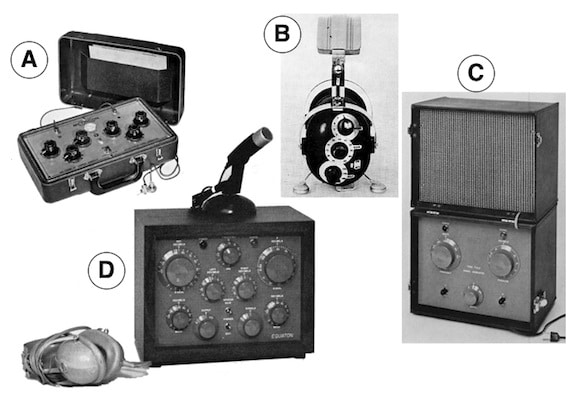Additional Historical Information Related to Fitting Hearing Aids Using Otometry
 Test Equipment
Test Equipment
Otometry was based on sound pressure measurements and a damped wavetrain signal (DWT). Because of this, instruments had to be devised to make these measurements. An instrument was required to generate and deliver the damped wavetrain signals at the sound pressures required for different frequencies. For other measurements, a variety of instruments were generated over a span of about twenty years with names as Equaton, Otomet, and Metricon (Figure 16 – Figure numbering continued from previous posts on this topic). Sound pressures were calibrated in 2-dB increments.

Figure 16. Otometry test equipment. (A) Metricon Decibel Meter. This can be set to specific standard frequency responses to approximate hearing instrument specifications later to be applied. Some free-field measurement could be made to test user reaction. (B) Later Decibel Meter or otometric standard hearing instrument. Instrument could be present by dial to have specifiable properties. Selection of definable properties enables free-field measurement to obtain “flat” comfortable loudness pressures for ears being evaluated. (C) Otomet free-field signal generator. This instrument delivers a damped wavetrain signal at a distance of 28 inches from the front. Aided or unaided hearing evaluation may be performed over the comfortable loudness pressure range. (D) Equaton Sound Pressure Comparator. This unit allowed testing of all otometry functions. It included a speaker and/or circumaural earphones.
Figure 17. The Vicon Hearing Instrument Analyzer was promoted as a complete acoustic laboratory designed for measuring the performance characteristics of hearing instruments. The separate units of the Analyzer could be purchased separately, with additional components added later.
Vicon Hearing Instruments Company also made the first measuring device for hearing aid electroacoustics intended for office use, to the best of my knowledge. The Vicon Hearing Instrument Analyzer was needed to measure the test hearing aid (substitution hearing aid) after obtaining the MCLPs for the different frequencies, and plotting the relative difference pressures. It was used also to measure the response of the prescriptive hearing aid after it was fitted. I recall seeing it first in Northwest Hearing Aid Service in Fargo, North Dakota in about 1965). It was an impressive device that included an oscilloscope and an enclosed test chamber (Figure 17). Since then, a number of hearing aid analyzers have been developed and accepted in professional hearing aid practices.
The Prescriptive Fitted Hearing Aid – Restated Otometry Basics
When a patient needs a hearing aid, the goal in fitting it is to return sound pressure most comfortable loudness sensation to the same level as for a “normal” ear (unrelated to threshold pressures). Victoreen did not see a hearing aid and a hearing instrument as the same thing, and otometry dealt only with hearing instruments. However, in this and previous posts on otometry, the terms hearing instrument and hearing aid have been used interchangeably.
Starting point: what a hearing instrument does for a deficient ear must begin with hearing instrument requirements that would be needed for a normal ear. A normal ear receives sound pressures at comfortable loudness pressures.
A hearing instrument for a normal ear should have a gain of one (unity gain). There would be neither gain nor loss when a received sound pressure signal passed through it and there would be no change in loudness sensation. That would be true for all frequencies (or, a gain of one at all frequencies). A hearing aid for a normal ear should not change the “pitch” of sounds received.
A hearing instrument for a ”deficient” ear is like a hearing instrument for a “normal” ear except that gain and frequency response are altered as required to re-establish normal loudness sensations at each frequency as closely as possible. It is assumed that proper application of sound pressures exists only when it has been shown by actual free-field aided measurement that proper loudness-pressures have been re-established. This is not presently accepted practice.
Side notes
I was fortunate to know John Victoreen. We were often on the same presentation program together. One year at aNational Hearing Aid Society meeting in Chicago, he was in the audience when I was speaking about hearing aid selection. He approached me afterwards and thanked me for speaking about sound pressures related to hearing aid selection rather than speaking in terms of audiometric thresholds (the audiogram). One of John’s characteristics was that he was dogmatic when it came to talking about hearing aid fittings. You had to agree with him on the major premise for the conversation to have meaning. For example, if he showed you a fork and said it was a spoon, the conversation could not progress unless you agreed that the utensil was indeed a spoon. So it was with sound pressure. One had to accept that sound pressure was the measurement issue, and not Hearing Level or Hearing Loss in dB, or the conversation went nowhere.
Next Post: Who Was John Victoreen?







Wayne – I flew to Colorado about 1970 and visited Vicon and John Victoreen. At the time, I worked in Rochester, NY and one of the dispensers there was a worshiper of Victoreen. I have enjoyed your articles.